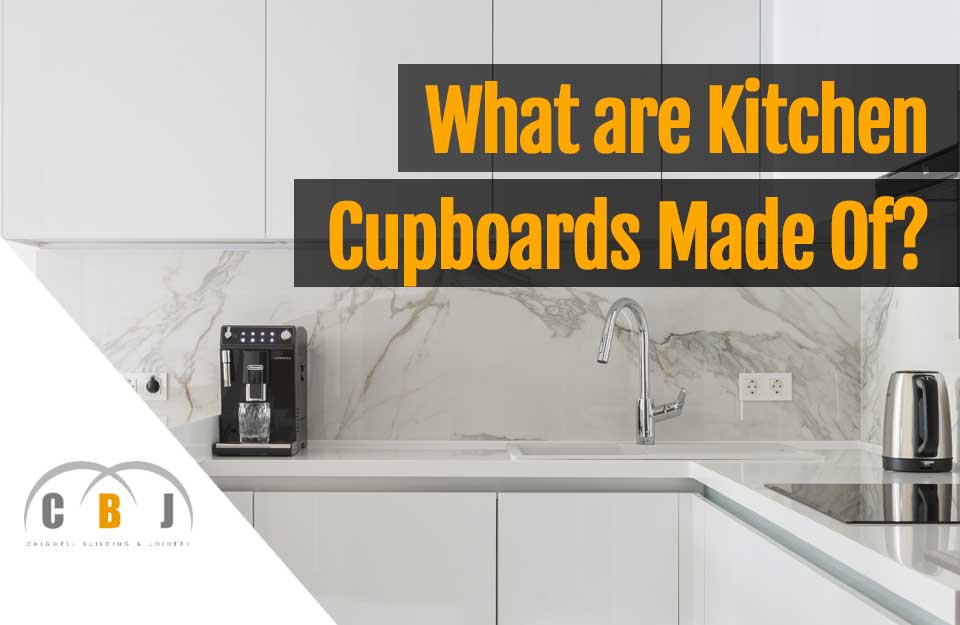
What are Kitchen Cupboards Made Of?
Author Chigwell Building & Joinery
Date 01/05/22
If you’re planning to design a kitchen renovation, or you’re in the process of ordering a new kitchen, you may be be considering the types of materials that you can choose from.
While kitchen cupboards can be made from a variety of materials, it’s important to be aware of the pros and cons of each.
This will help to better position yourself when choosing a material that suits your needs and budget, as well as offering good value for money.
After all, buying or renovating a kitchen is not something that you do very often.
So it’s best to choose appropriately for your circumstances and needs.
Table of Contents
- Melamine Faced Chipboard (MFC)
- Advantages of MFC Cupboards
- Disadvantages of MFC Cupboards
- Polyester
- Advantages of Polyester Cupboards
- Disadvantages of Polyester Cupboards
- Solid Wood
- Advantages of Solid Wood Cupboards
- Disadvantages of Solid Wood Cupboards
- Plywood
- Advantages of Plywood Cupboards
- Disadvantages of Plywood Cupboards
- Wood Veneers
- Advantages of Wood Veneers Cupboards
- Disadvantages of Wood Veneers Cupboards
- Medium Density Fibreboard (MDF)
- Advantages of MDF Cupboards
- Disadvantages of MDF Cupboards
- High Gloss Thermofoil
- Advantages of High Gloss Thermofoil Cupboards
- Disadvantages of High Gloss Thermofoil Cupboards
- High Pressure Laminate
- Advantages of High Pressure Laminate Cupboards
- Disadvantages of High Pressure Laminate Cupboards
- Metal
- Advantages of Metal Cupboards
- Disadvantages of Metal Cupboards
- Conclusion
Melamine Faced Chipboard (MFC)
Image credit: CBJ Ltd
Melamine faced chipboard is the most popular material for kitchen cupboards.
In fact, the majority of kitchen cabinets in the UK are made from MFC.
Chipboard, or particle board as it’s sometimes referred to, is made from small chips of wood.
These are glued together, and compressed under high pressure to ultimately form a panel.
Then this is laminated with a melamine outer surface.
Melamine is essentially decorative printed paper.
This layer is soaked in melamine resin and then fixed to the chipboard to achieve the final product.
MFC strikes a good balance between several advantages, while remaining considerably affordable.
Let us delve a bit deeper into this type of material.
Advantages of MFC Cupboards
- MFC is available in several designs and colours, so the likelihood is there’s something available to suit everyone’s preference.
- Thanks to modern printing technologies, the printed patterns and effects are incredibly lifelike.
- Sometimes it’s almost impossible to tell whether it is MFC or real wood.
- MFC cupboards are very affordable, especially if you were to compare them to solid wood or plywood cabinets.
- One of the main advantages of MFC is that it’s a stable material. Even if subjected to changes in temperature and humidity levels, which is fairly normal in kitchens, it is not likely to warp or twist.
- The surface of MFC is water proof and very resistant. In a kitchen where water, spills and stains are commonplace, it’s important to have such a feature so that you can wipe it clean without having to worry about damage. That said, this only applies to the melamine surface, as the chipboard panel core is most certainly not waterproof! Therefore, any spills should be wiped off immediately. This helps to prevent any liquid from reaching the edges of the panels and making its way to the chipboard core. To counter this issue, many modern panels are now sold with edge banding finishes made from water resistant adhesives that are better able to resist moisture penetration.
- There is no need to worry about re-staining or re-sealing MFC, as the printed image is permanent. As previously mentioned, they are very easy to clean.
- There are also automation benefits, since such panels are made to industry standard identical sizes.
Disadvantages of MFC Cupboards
- While MFC is considerably durable, it is still a bit susceptible to dents and scratches.
- On some cheaper options, edges can also chip very easily, exposing the chipboard core.
- Cabinet shapes are, as a rule of thumb, squarish, and so there is no room for choice of shape.
- Since melamine is somewhat heavy, it might be a bit prone to sagging over time.
Polyester
Image credit: Pixbay
Polyester kitchen cupboards are another option, though not quite as popular as MFC.
This material is made up of melamine which is blended with pine fibres, and then coated with polyester film.
Advantages of Polyester Cupboards
- Polyester is quite affordable, although a little more expensive than MFC.
- Polyester is a considerably resistant material, and it is more scratch resistant than melamine.
- When it comes to colours and patterns, polyester is available in a myriad of different options, offering a great variety to suit diverse preferences.
Disadvantages of Polyester Cupboards
- While polyester cupboards are quite scratch resistant, should they be scratched it is very difficult to repair or retouch them.
Solid Wood
Image credit: Pixabay
Solid wood is not a particularly popular construction material for kitchen cupboards.
This is mainly due to the fact that natural growth and contraction of solid wood makes them rather unfeasible for kitchens.
Having said that, solid wood kitchens which are freestanding, and not made to be fitted from wall to wall, are sometimes made from solid timber.
Advantages of Solid Wood Cupboards
- While they do have some disadvantages, there’s no denying that solid wood cupboards are very stylish.
- The natural unique tones of wood offer a timeless beauty to a kitchen.
- With solid wood, you have the opportunity of choosing from several natural colours, from cherry and oak, to walnut and maple.
- Other popular options are knotty pine and hickory.
- Solid wood is highly customisable, and so one can choose according to his particular preferences.
- Solid wood is very strong and durable, and so you will benefit from a long lasting kitchen which is highly resistant to scratches. In case of any scratches that may occur, there’s not much to worry about as you can easily repair or buff.
Disadvantages of Solid Wood Cupboards
- The main disadvantage of solid wood is that it’s expensive, especially if the kitchen is large.
- Unfortunately humidity causes solid wood to warp or even crack over time.
- This is a natural reaction of solid wood to humidity.
- Solid wood cabinets are generally treated with a waterproof finish.However, it’s still important to make sure that they are properly maintained over time, such as by using suitable, non-abrasive cleaning products.
Plywood
Image credit: Wikipedia
Plywood is becoming increasingly popular for kitchen cabinet carcasses.
Even though it generally costs more than MFC, it is structurally far stronger.
This offers advantages for fixing and assembly.
Moreover, thanks to this flexibility, it is easier to make modifications.
Advantages of Plywood Cupboards
- The plywood surface will be varnished and easy to clean if dirty.
- Plywood is generally considered to be very strong and durable, due to its layered construction.
- Plywood does not require re-staining after any lengthy period of time.
- Plywood is highly durable and resistant to shrinking and warping as well as cracking.
Disadvantages of Plywood Cupboards
- It is important for the edges of plywood kitchen cupboards to be finished as well as the main surfaces.
- Plywood is known to emit toxic VOCs (volatile organic compounds).
Wood Veneers
Image credit: CBJ Ltd
Chipboard kitchen cupboards can also be covered in real wood veneers.
That is, by a thin layer of real wood which is glued onto the chipboard panel.
As a result, besides the stability that chipboard can offer, there is also the added advantage of the natural variations of real wood.
Advantages of Wood Veneers Cupboards
- Veneered cabinets look very natural as they are actually made from a thin layer of real wood, thereby offering both the look as well as the feel of natural solid wood.
- Wood veneers are quite durable as well as resistant to warping.
- Relatively speaking, wood veneer cabinets are cheaper than solid wood kitchen cupboards.
- This is not a problem at all in most cases as nicks and scratches can be easily buffed out.
- Simply wiping down with a soft damp cloth can keep these cabinets in great condition for a long time.
Disadvantages of Wood Veneers Cupboards
- Most veneered cabinets are not as durable as solid wood.
- In case of too much moisture the veneer will end up loosening from its base, resulting in what is commonly referred to as a bubbled look.
Medium Density Fibreboard (MDF)
Image credit: Beers
MDF is made from small particles of wood fibre.
These are mixed with wax and resins.
Using MDF offers various benefits, and it looks very nice.
Advantages of MDF Cupboards
- Smooth and even grain.
- Stability is another benefit of MDF, since this material is not prone to expansions and contractions as natural wood is when exposed to changes in humidity. It is also less prone to warping.
- MDF can be easily painted and repainted.
- Flexibility when it comes to crafting different types of cabinet styles.
Disadvantages of MDF Cupboards
- Is not heat resistant and in case of very high temperatures it will be damaged.
- In case of chips and scrapes the cupboards will most likely be unrepairable since it is not possible to sand MDF.
High Gloss Thermofoil
Image credit: Pexels
High-gloss thermofoil is made from a glossy vinyl coating over the base material.
Advantages of High Gloss Thermofoil Cupboards
- Easy to clean.
- Aesthetically pleasing.
- Warp resistant.
- Does not fade over time.
- Since the material has a glossy, reflective surface it makes the kitchen look brighter and gives the impression that it is more spacious.
Disadvantages of High Gloss Thermofoil Cupboards
- Cannot be painted.
- Hard to cover up scratches.
- Fingerprints, smears and smudges are very evident since the surface is so reflective.
- Even though over time HGT cabinets have been made to be more resistant and durable than they were years ago, they are still quite vulnerable to heat and moisture.
High Pressure Laminate
Image credit: CBJ Ltd
High pressure laminate is quite similar to melamine.
It is manufactured in multiple layers, which are pressed together by means of very high pressure, thus the name.
Advantages of High Pressure Laminate Cupboards
- There a variety of colours and finishes one can choose from.
- Easy to clean and no need to stain or finish it.
- Resistant to chips and scratches.
Disadvantages of High Pressure Laminate Cupboards
- HPL tends to be more expensive than melamine, but still quite affordable when compared to other materials.
Metal
Image credit: Steel Kitchen
While definitely not as popular as the other materials mentioned above, metal is also used to make kitchen cabinets, especially for professional catering establishments.
Advantages of Metal Cupboards
- Durable and sturdy.
- Easy to clean.
- Easy to install.
- No warping problems.
Disadvantages of Metal Cupboards
- Looks cold.
- Considerably harder to design.
- Rust may be an issue unless proper maintenance is carried out.
Conclusion
Now that we have comprehensively covered every type of kitchen cupboard material available, including their pros and cons, we hope that you are now in a better position to make a well informed decision to choose the best kitchen cabinets.
As you will have discovered, each material has certain advantages over the other.
So it’s important to choose wisely so you fully benefit from longevity and value for money, plus get the look and finish you desire.


